Before I get going in earnest let me start by admitting my own bias. I haven’t actually lived in Trinidad and Tobago for well over 25 years now. As much as I’ve tried to keep up with the local game, it’s been through the media and I fully appreciate that being ‘on the ground’ provides an invaluable insight into our footballing landscape.
Also, I am a product and a huge fan of the Secondary Schools Football League (SSFL)—or the Colleges League at it was called back then. As much as I represented T&T at just about every youth level as far as I can remember, without my ‘escape’ to the Colleges League, I can say with some certainty, I would’ve quit the game by age 16.
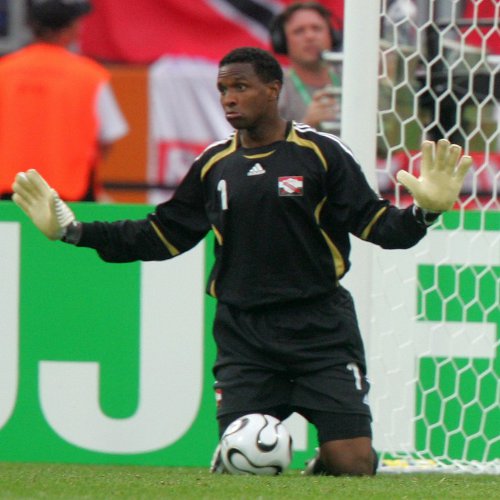
(Copyright AFP 2014/Roberto Schmidt)
So please don’t try to convince me that the Secondary Schools Football League is detrimental to our game. Please, don’t.
Over the last few years I’ve been afforded the opportunity to interact with some of the major stakeholders and decision makers in the game, regionally and globally. Regionally, particularly in the United States and Mexico, the approach can be summed up by the saying “a rising tide lifts all boats.”
I can’t tell you how many times I’ve heard that phrase used over the last 18 months or so. The objective isn’t to gleam the cream off the top, but to raise the standard of the game at every level. By doing so, those at the top would ultimately benefit most.
And let’s be honest here, taking the best players out of the league would effectively kill the SSFL, and with it the opportunity for those players who may not be deemed good enough or do not want to play at a Pro League academy. At 16 or 17, I would’ve fallen into one of those two categories.
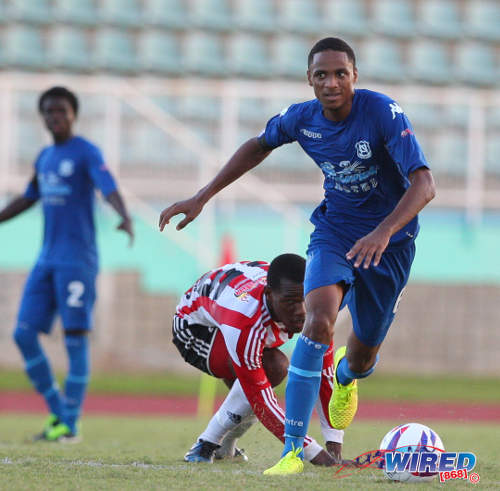
Watson, a sixth form student, is also a W Connection player.
(Courtesy Allan V Crane/Wired868)
Apart from which, why is the SSFL to blame when “we have boys who should be fighting for a place in W Connection or Central’s first team at 17, 18 or 19 choosing to play school’s football?”
There are any number of people you can castigate for that: the TT Pro League, the clubs, their academies, the coaches, the player, the player’s parents, look you can blame Brer Anancy for all I care. But you surely can’t blame and consequently punish the SSFL for giving a player an opportunity that he enjoys.
Through all the talk and suggestion about what or who is at fault for our recent failings and how it should be addressed, I believe it is high time that we have an honest and earnest discussion about our football. We need to define our footballing identity and let that be the foundation on which all of our game is built. We have to get away from this four-year shifting of focus, that merely reflects who won the last World Cup. (We aren’t the only ones guilty of this by any means).
After 1998 when France won, there were calls for a Bloemfontein-esque national football academy. Then in 2002, we needed to play more beach soccer and futsal—a game I’m a huge fan of as a development tool, but that’s for another day—like the Brazilians do.
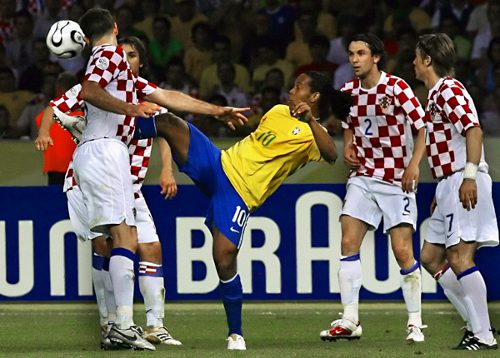
(Copyright AFP 2014/Antonio Scorza)
After 2006, we needed to be better defensively and tactically just like the Italians. In 2010, we needed more tikki-takka (more on Spain in a minute) as Spain rewrote the way the game was supposed to be played. And now we have to be more disciplined, just like the Germans.
When and where will this nonsense stop?
I read somewhere that, late in the last century, Spain’s footballing minds sat down to have a look at their consistent failings and how it should be addressed. They admitted that they’d never be able to match the likes of the Germans and the English in a physical game. Their fans didn’t want to see them playing defensively like the Italians, even if it meant winning 1-0. But they knew they were very good technically.
The resulting philosophy was simple, if we had the ball the opposition didn’t, they couldn’t hurt us and we’d dictate the game for the most part. And so tikki-takka was born.
They then set out to certify as many coaches as possible, at every level—Spain has more certified coaches than almost anyone—so that everyone, from the bottom to the top, understood the philosophy.
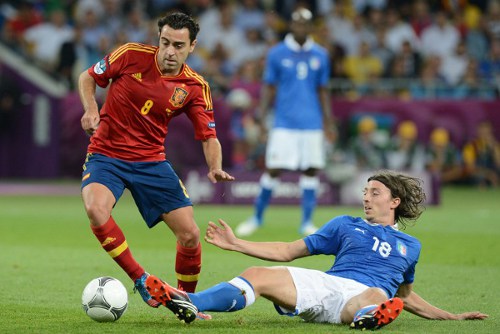
(Copyright AFP 2014/Patrick Hertzog)
Yes, they were buoyed by Barcelona playing similarly, and the success that they had. And, yes, the style may vary slightly depending on the personnel or the coach. And, yes, you may criticize tikki-takka itself. But what you cannot question is the success that having a clear national footballing identity has brought to the Spanish national team.
Back in the early 2000s, I met with the newly appointed Minister of Sport, Roger Boynes—I really can’t remember what was the intended nature of the meeting—as it happened, the soon-to-be Minister of Sport Anil Roberts was also present. The TT Pro League was still in its infancy.
I suggested that the approach of the league could better benefit all of our football. I felt, and still do, that clubs should align themselves with schools in their region. The clubs would have first ‘dibs’ on the players coming out of those schools, that’d ensure a natural progression of the talent coming out of the SSFL.
Probably more importantly, given the crowds at Pro League games, there’d also be a natural progression of the fan base—the SSFL was well supported back then.
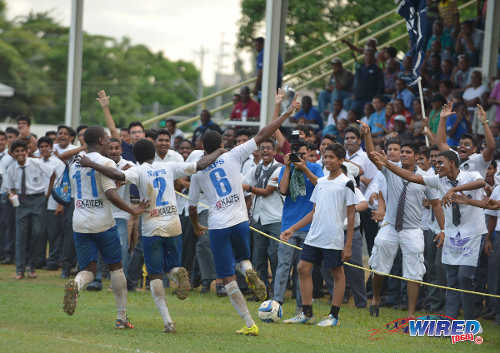
(Courtesy DP Images/Wired868)
The Pro League club would also be responsible for sending coaches to oversee and assist in the coaching of the school teams, ensuring that all the players were exposed to the professionalism it takes to earn a living playing the game, the best players were well educated in the club’s philosophy and the club’s young and upcoming coaches were given an opportunity to gain valuable experience.
The investment and benefit would be mutual without affecting either’s autonomy.
As luck would have it—and, yes, I’m fully aware of how politicized our football has become—there is a TTFA Presidential election and a general election coming up this year. Regardless of their outcomes, whoever wins will have the minimum security of a four-year term to properly address the game.
It’s high time to get all our game’s stakeholders—the TTFA, TT Pro League, SSFL, Primary Schools Football league, Ministry of Sport, Ministry of Education, coaches and commercial partners—to define our own footballing identity.
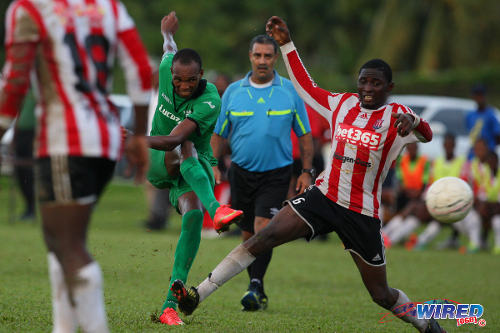
(Courtesy Allan V Crane/Wired868)
How can we lift all boats? Let that be our New Year’s resolution for 2016.
Progress, after all, is not a zero-sum game.
Shaka Hislop is a football analyst with ESPN and a 2006 World Cup player with Trinidad and Tobago.
He played professionally in England with Reading, Newcastle, West Ham and Portsmouth and has an Executive MBA in Business Administration and a Mechanical Engineering degree from Howard University.
He was inducted into the Hall of Fame athlete in Trinidad and Tobago and Howard while he was the inaugural winner of the England PFA’s Special Merit Award for his services to football.
 Wired868 Wired868 for smart sport news and opinion
Wired868 Wired868 for smart sport news and opinion
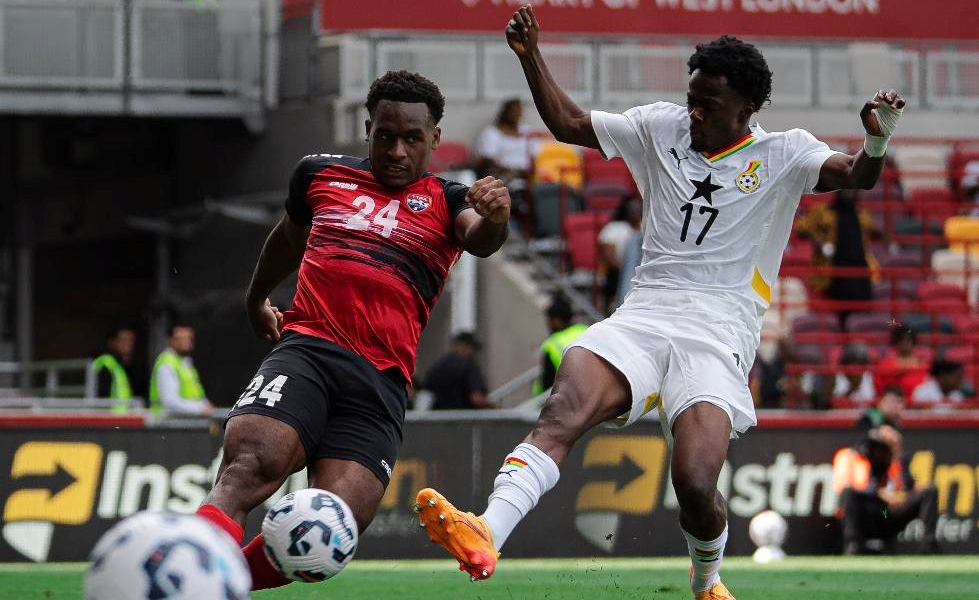

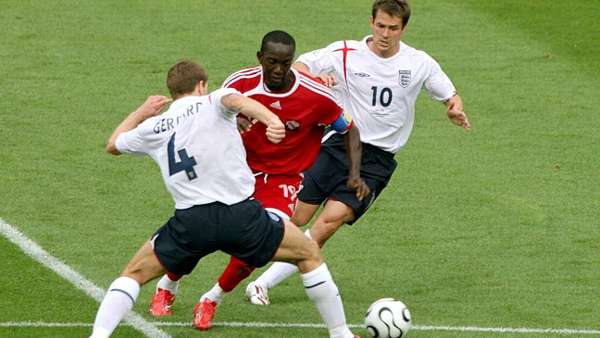




The need to bring that for the age groups. Assign local coaches to them. And keep the zones as teams. Let them compete and train together. That’s the quick fix until the pro leagues get academies. But in that they won’t pay the coaches so. That might never happen lol
Lasana.. It will be quite difficult.. A real challenge to change everything. The main issue will be money to implement a new approach. There will need to be a change in tradition. The really talented kids need to see the Pro league as the ultimate in Trinidad and Tobago. They must aspire to play in the league. To do that the Pro league must first market itself as organised and professional. A league that can be a stepping stone financially and professionally. We are not a footballing country so those with the resources to help wouldn’t. The right people need to convince businesses to invest in the youth. Each club should have a professional organised youth set up to develop the kids. A prerequisite to this development are good coaches. I’m extremely critical of coaching in Trinidad and Tobago because of what I put up with as a young player. It may be a struggle to find enough good coaches to develop players. It all comes down to finance and the right persons to implement it in the clubs. No way is it in any way impossible. It just seems that way because jokers run football.
I think the answer to that is no Prince.
Do they still do those east west north south screening?
I agree with everything you said Kelvin. The thing is how do we improve things within the context of our football. I fear that waiting for Pro League clubs to get proper academies might by too long.
Lasana.. I’ve had this conversation with you many many years ago. I strongly believe that schools football, as exciting as it is for many, hinders a players development. To compete in those U17 and U20 tournaments, I mean really compete, our players need to be training like professionals. they will be encountering professional players in these tournaments with hours upon hours of work behind them. These players will be miles ahead tactically, technically and fitness wise. Now, because one and one is not two many times in football we sometimes get this false sense that we are close because we “only” lose a game 1-0. But anyone who may have seen the game would realise that although we lost 1-0, the proper score is “6-0” – such was the dominance of the other team. Occasionally we will even win a game or two but again is not by design. Those who played schools football probably loved it. I attended Holy Cross College so we had no school team there. I played in the East Zone for Trincity United. I may come over as arrogant but back then I viewed myself as superior to those playing schools football because I was training and playing against men. I knew I was ahead of them all tactically.. Although the ones playing schools football had a bigger “name”, I always knew that they could only use that “name” gained from playing intercol for a time.. Schools football is outdated and big changes need to be made. It may prove difficult because of the historical factors involved.
i am saying let the kids progress through the school system, replicate the american system. in america kids ‘pay’ their way through the system. in trinidad that wouldn’t work, so that’s my point. the academies you speak of travel to barcelona, rome etc to get invaluable experience at a young age which our kids hardly ever get at yth football level. we can hardly get a trip to barbados or grenada. so i am saying maximise the resources we have.
Travis in the American system. They have academy programs now that they pick the national team from. A lot of the top players in the state play for these clubs. Most of these clubs do not allow their kids to play highschool. Some do. Also club soccer is far more important than high school. College coaches do not go to highschool games to recruit. Unless they already saw a kid through club and the showcases. High school in the states is for fun and bragging rites very diluted. Club soccer gets you into universities and pro teams
because every one is looking at the european model,i don’t think it suits us .the american model is more conducive in my opinion. ie. middle school,high school,college -Pro .of course we have primary,secondary -Pro. Also you say that cause ya’ll aren’t inside the system to know how shitty it is at yth level.in terms of organisation,refereeing etc etc.but trinidad is full of opinions as they say its like noses.
All great points. The SSFL can still serve a huge purpose with out the better players. Others will be able to showcase some talent.
They (administrators) need a plan. It’s going to take just more than “playing football”. But I don’t know what’s happening.
Travis Mulraine, I started off more on Look Loy’s side here in that I felt the long term solution had to be clubs running the development like Kirwin Weston said.
But, honestly, the Pro League is a decade or more away from being able to provide an environment for students to be able to play with their clubs. For that reason, I think we have to continue to use the ssfl and merely encourage players to progress to a more testing level at a particular age.
Travis Mulraine I hear your points on finances, infrastructure, and resources. However, I am still advocating the ProLeague as the main avenue for development of players. Currently, focusing on the school system is more logical but we need to look long term. I believe, the ideal is to have the ProLeague functioning optimally on all levels. From youth to seniors, so the tranistions from U-12 to Seniors, to transfers abroad is as smooth as possible. I believe our goal as a country is to produce skillful players who can make it out there in the higher leagues (Europe, North America, South America). I’m not sure how it can be achieved through the school system. I’m not saying it’s impossible, but given the nature of other professional issues, I believe creating a sustainable professional league is the way to go.
i see all your points Las but i am in in favour of the schools leading the way not the other way around. most clubs DON`T have the resources be it financial or infrastructure to run a proper football program that most schools do. let’s take your beloved CIC, the facilities at serpentine rd is not matched by any pro team maybe if queens park ends up in the pro league well then. so let the schools deal with development from 6-18, in partnership with the clubs, and after that period let the clubs take over.
Shaka Hislop: “Let me restate my major points more succinctly, as it seems they have been misinterpreted by some.
• The clubs and academies will raise the level of the SSFL by the clubs taking responsibility for the school coaching.
o This allows the clubs to have a direct insight and impact on all the school’s players (raising the tide) and better identify those who may eventually be good enough to play ProLeague football.
o The player gets to continue playing SSFL as he may choose, or enroll full-time in the academy, as he may chose. I repeat “as he may choose” intentionally.
o If a club is responsible for 14 primary and secondary schools (for argument’s sake), there will be an opportunity for 14 professional, aspiring, youth coaches to further develop their own abilities coaching a team of their own, under the direction and with the support of the club, as opposed to having 14 of them bumbling over each other trying to look after a team or two at the stand-alone academy.
• The SSFL will raise the level of the clubs, their academies, and their respective leagues by providing a natural progression of their fan bases. As an example I don’t at all identify with a ProLeague club, but I’m an avid supporter of all things CIC. I have a CIC football shirt, I’d watch a CIC game online, I’d be a proper fan. I’m not sure how many people feel similarly about a ProLeague club. And I suspect that I’m not in the minority in this.
Ok, I get it that SSFL may thin out the players pool a little too much (the new league format should address that) but the league runs for 4 months. The European academy season, which many are advocating for runs for about 8 months themselves.
What I’m saying is, the SSFL should, and deserves to, have a role in our national footballing identity and development.
I feel another article coming on. ☺”
Let me restate my major points more succinctly, as it seems they have been misinterpreted by some.
• The clubs and academies will raise the level of the SSFL by the clubs taking responsibility for the school coaching.
o This allows the clubs to have a direct insight and impact on all the school’s players (raising the tide) and better identify those who may eventually be good enough to play Pro League football.
o The player gets to continue playing SSFL as he may choose, or enroll full-time in the academy, as he may chose. I repeat “as he may choose” intentionally.
o If a club is responsible for 14 primary and secondary schools (for argument’s sake), there will be an opportunity for 14 professional, aspiring, youth coaches to further develop their own abilities coaching a team of their own, under the direction and with the support of the club, as opposed to having 14 of them bumbling over each other trying to look after a team or two at the stand-alone academy.
• The SSFL will raise the level of the clubs, their academies, and their respective leagues by providing a natural progression of their fan bases. As an example I don’t at all identify with a ProLeague club, but I’m an avid supporter of all things CIC. I have a CIC football shirt, I’d watch a CIC game online, I’d be a proper fan. I’m not sure how many people feel similarly about a Pro League club. And I suspect that I’m not in the minority in this.
Ok, I get it that SSFL may thin out the players pool a little too much (the new league format should address that) but the league runs for 4 months. The European academy season, which many are advocating for runs for about 8 months themselves.
What I’m saying is, the SSFL should, and deserves to, have a role in our national footballing identity and development.
I feel another article coming on. ☺
its about time someone sees the bigger picture
There is a compromise. Shaka and players like him can represent their schools until the age of 16. And then the players who want to develop further can be coaxed into club football.
I think it should be voluntary though. I don’t agree that a law should necessarily be passed.
It would be up to the national under-20 coach and the club coaches to persuade the players one way or the other. And to select them or not.
It’s to late by then to develop world class players. We should have a very good idea by U12 who may become a world class player. It is not fool proof, but this age level 12-14 is where players are “made”. There will always be players who are late-bloomers, but this can also be identified in an academy setting. This is why we need academies with quality coaches directing the development of our football. School is for learning and school sports is for recreation.
The US is making massive moves to get youth players into MLS academies where they live and train and go to school under the guidance of top quality coaches. Now they are trying to expand it to the U14 age groups. Do you think Naps or St. Mary’s have the time and resources to compete with that? Look at the last U20 qualifier. Our players were school boys for the most part, while many of the other teams players were coming from pro club.
Donkey in horse race.
We need to think big and make a concerted effort to completely change our approach to how we think, see and interact with football. That’s if we want to be World Class.
Maybe it’s because I’m not on the ground, but isn’t this how it is right now? As far as I gathered players have the choice, but they chose to play SSFL. And that apparently is why we’re failing, because teenagers today are making the exact same decisions that we would have made at their age.
Many other things,too,Lasana.But let it pass.
Melville Foster, the only way the Premier Division can fulfill its aim of a concentrated talent pool is by mass transfers to the 14 schools in the top division.
That can’t be good. It is much easier to cover school football now and I’m sure the Premier Division helps the standard in terms of the concentration of maybe coaches.
But, like you said, those transfers are something to keep an eye on because it can disrupt students’ education.
If the Pro league is as good or organised as Look Loy presents then how can a team newly introduced to the league be leading the standings. Doesn’t that speak to the quality of the league. Good individual players will be developed by an interested coach, scout, or mentor. The SSFL is a stepping board for media recognition and national awareness of other player. Getting them out into international circulation via scholarships/ contracts as early as possible is their most viable chance. They then have the option to play for us. Other than that it will be a merry go round of mediocrity that will doom young players to obscurity time and time again. Who was the last local player to make it into a significant club in recent times? We should be looking to leagues closer to home to get players into also. The MLS is only one option. There are many more
Very well said
Shaka’s ‘bias’ discounted, significantly, anything that came after it. I am going with Look Loy.
Trinidad and Tobago is known for bypassing sense and going for nonsense though. if this does happen I could see it helping Trinidad immensely. But it’s a big IF.
primary schools an all are cherry picking. a few schools have linkages with the community teams—Arima Boys is a case in point. but if you look at the typical school in the POS & Environs district (the largest school district in T&T) most of the schools do not have a proper coach. the PE teacher walks around with a list and pulls out kids he knows can play, gives them a kit and runs them out. sink or swim has nothing to do with any system. its pure luck and chance
What happened to the primary schools league? Big in the 60s and changed the lives of many boys including my dad.
when Shaka talks about playing as a 17 year old in Saints…he was the first string keeper and he as ALSO able to get the grades to be a credible academic candidate for F6. how many of his Form 5 teammates DIDNT make it into F6?
the top teams in the SSFL are teams with a soft transition to Form 6 and repeating Form 5. schools with a heavy academic workload will never be competitive against schools where footballers—not just a few, but the whole team—get a free pass into F6
by time a kid reaches Form 4 and start to be on the radar of the secondary school First 11 teams, a very significant number of male students have already dropped out of school. we dont want to study the linkages of drop-outs to a shrinking talent pool
the Form 1 league is also not about development—those kids can play already. and they are just pulled into the school’s system.
under 14 and under 16 are basically second-thoughts, and are not seen as primary focus of any but the best programmes.
What no one speaks about is the raiding by prestige schools of students ,with superior foorball skills,from the composite,junior and senior secondary schools.
always the cherry picking.
school ball back in the 80s was very different to the state of football now. it had a much more significant place in the development model.
now? not so much. But the reason the footballers were better THEN is not because of any magic.
there were fewer “good” teams and those teams had the best players. now the players have spread out—which is more a case of the vast increase of the number of secondary schools and the Ministry of Education zoning policy.
ostensibly, there are footballers going to schools that do not field proper teams. that accounts for a small but significant segment of the available talent pool coming out of SEA.
A student should be free to play for his school if he wants. No problem. But it makes the job more difficult for national coaches and they have to act to suit.
The reality is Trinidad and Tobago does not play against schoolboys at under-20 level.
Shaka gave good suggestions to improve the SSFL. But, at the end of the day, the SSFL has a different function. So that might help in the short term. My personal belief is we need something else for the long term.
“A student should be free to play for his school if he wants. No problem”, is exactly what most who are proposing killing the SSFL, including Mr. Look Loy, are advocating against.
SSFL should be footballers who have no future in football. It will give them an opportunity to be a star in school and then move on with their life and leave the youth league to the future national players.
“SSFL should be for footballers who have no future in football”…like me. Sorry couldn’t disagree more.
Having said that, I can’t see clubs leaving youth development up to schools as being a practical long term solution. I think his proposals make for an improved situation at present.
But I still see Look Loy’s plan working best in the long term. And that is after 16, the best players focus on the club game with the clubs ensuring that their players’ academic responsibilities are still met.
I really don’t understand why the success of club academies depends on the failure of the SSFL. A league that lasts for 4 months remember. Leaving as much time as any other academy league worldwide for the clubs to accept sole responsibility for the players.
What I’m saying is the SSFL and even minor league football needs to be part of clubs’ development picture. It is not one or the other.
How can minor league aid development? I haven’t been to a minor league in over a decade. So it confuses me more than anything else.
I’m curious on that point especially.
Further, I make the point that the youth development, though within schools, is directed by the pro club/academies.
Back then the quality of the Colleges league was very high where players went straight onto the National Team eg. Clint Marcelle, Anthony Sherwood, Dwight Yorke, Arnold Dwarika etc.
We really have to decide to structure football properly to advance we cannot support both a youth professional league and a school league. Take a page from the USA but by having a schools amateur league and having a draft at 18 to professional clubs. Let clubs concentrate their resources on adult football and development camps for youth footballers based on region so that they can impact general football progress. Of course this means that all schools must have resources financial, technical and physical to enable them to advance.
Finally someone with some sense
Is how I made it in a pic nuh
Right great !! Now to Action out this stakeholder meeting to forge our football identity. It should be action-ed by the Ministry of Sport. More succinctly our new Minister of Sport Brent Sancho .
Agreed
definitely a lot of great points made here (Y)
I agree with some of the idea Shaka put out, but his main premise that SSFL is needed as a tool towards international development is not true. I am a fan of Shaka and respect his experience, but the mental side of the game that he alluded to cannot promote professional and international caliber players. Why would a player who is desirous of playing at Chelsea, Barca ,or Bayern have a need to escape to school football? This is a major reason why the “pro” league player absconding to Carenage and Santa Cruz to play minor league football. We cannot mentally sustain the pressures of organizational structures. ever wonder why we continue to give up goals late or cannot defend properly?
The countries that still have school football as a pathway to National and International football are not “relevant” in the footballing world. School football should be seen as a grassroots tool. One which provides an opportunity for the would be player an avenue to participate. Culling the best out of school football can be seen – like Shaka did – as diluting the field. However, I believe that the departure of the “better” players would provide a platform for other “stars” to make their mark.
Attendance is routinely used as a marker in highlighting the difference and acceptance of the leagues. It is easy to understand why school football will draw huge crowds. This cannot be a yard stick for the development of our football. Many people espouse the decline of the quality of play in the league compared to yesteryear, but yet the fan support is almost consistent across the years. What gives. The pro league needs money to sustain their program and to build a true professional club. Attendance right now should not factor into their budget as an income. They need to find alternative , creative means of generating financial sustainability. Their focus should be placed on improving the quality of the product they put on the field through proper development of individual players. If people believe that when they attend a Pro League game they will be entertained, then they will attend. Generate greater entertainment.
What type of players do we want? Decent players or professional players? If we want the latter, then we will have to provide a professional environment for players to develop, surely Shaka knows this. We will not consistently qualify for world cup or become a credible entity in soccer if we continue to insist that school soccer is the way. It is not.
Now the idea that clubs should develop a relationship with local schools is a very credible and doable initiative. This relationship still cannot replace or meet the needs of what is required to develop world-class players and a strong consistent National team.
With regards to the people who keep talking about the SSFL produced Sherwood, John, Nixon, Dwarika et al . They had no where else to play. That’s it. Nothing else. See we had a handful of players come through the SSFL and we believe that is proof that it works. Well even a broken clock is correct twice a day. one of these schools have/had a program to show you how these players were developed. The players came through the SSFL because that is what was readily available to them.
Let’s truly make a move to develop world class players by developing professional academies and programs. Not a style of play, but a developmental process to achieving highly technical, tactically sound, physically ready, and mentally astute players consistently and continually. Players who do not need to escape to a lower level to gratify or nurse their egos, but players who can soak up and relish the pressures of being a professional and accountable day in and day out. Then maybe Vietnam, Hong Kong, India, and Iceland will not be our players first stop on their way to International nothingness.
Could not agree with you more Rozano Fortune. Very tough decisions are definitely needed if we are to succeed consistently at the very highest level. A lot of people fear the unknown..but for so long we have done things by shooting fom the hip (sometimes hitting..most times not) that our vision has become skewed by the very limited success of doing what was wrong in the first place.
It’s an interesting perspective, probably shared by many others. His summation which essentially states that all stakeholders should come together to develop a cohesive agenda designed to lift the standards is right on point. It’s long overdue…
Thank you Shaka, on point with you opinion
Hmmm…I think this has all been said already but remains hypothetical.
Sometime recently, I remembered stressing what Shaka is advocating, only, he went into more detail about the structure and the stakeholders…Point is, as Shaka said, we have to all get together at all levels and come up with a common plan for our football from school thru college to national/ overseas//professional etc.,but all levels must be included so as to impress upon everyone that a particulat inclusive system is necessary for the progression of our football. Dialogue, discussion, planning, executing…an ALL INVLUSIVE PLAN FROM SCHOOL TO PRO LEAGUE, whether local or foreign is necessary….moreMANDATORY.
I agree with Shaka’s point of view.
Now!!! That i fully concur
I think the transitional idea is a good one especially with the fan base. As a former Malick Secondary student my first pro league games were to see Tinto and Theobald play for Calidonia simply because they were my schoolmates but I was no longer in school. i SUBSEQUENTLY grew to like and recognize players from other teams and i remember when Carlyle Mitchell was a striker and Toussiant was the greatest thing for W connection. That being said teams that are based in areas where the football catchment is weaker than other areas can have an unfair advantage in acccess to the best players.
A lot of former players and coaches on this forum see this as a SSFL versus TTPL option. From reading the comments thus far it seems that there is no magic formula. There are good arguments both for and against.
SSFL pros are: a good education; well balanced student/ athlete; engaged young players (if only for fleeting fame); supporting crowds (which encourages media attention and business input). To name a few.
It’s cons are: hampered and under development of the players; unqualified coaches and players unable to work at a professional level.
TTPL advocates cite, the opposite happens in the Pro league. Players can develop professionally in the league.
To me there isn’t ONE yellow brick road. The challenge is to change and know what changes are needed at any particular time. In Shaka’s heyday, CIC, made up of student athletes challenged the national team (Sando Technical) and won. A few players from Sando’s team went on to become professional players, Shaka went on to eventually play professionally. But it is instructive to note that the level of football and the crowd support, formed a psyche for both players and supproters and was instrumental in us getting so close in 1989 and eventually in 2006. Playing with players at a higher level means that either you improve or fall aside. Every year the Schools League produced a gifted player during that period. Arnold Dwarika; Stern John; Jerron Nixon; Anthony Sherwood to name a few (there were many others). I am sure that there are a few now that deserve some scrutiny but how many can be seen as having the amount of potential as these had.
They all passed through the SSFL and progressed through different avenues, but they all paid their dues. The times have changed, the level of competition isn’t what it once was, thus there is no cream to rise to the top. The level is better in the TTPL but it is not as rewarding or recognized. The administrators are non existent. The reality is this: If you don’t have any backing (parents or otherwise) you take your chances with the schools (for the glory), until you’re to old to play. In the meantime you play with one of the TTPL teams hoping for a contract outside. For the ones that are being backed financially, their parents take them out regularly to attend foreign camps so that international coaches get a chance to see them. Some local scouts and coaches also do the same thing. But there is a time frame for a sportsman/ woman. Most won’t make it professionally.
And as for the national teams, well…. they are NATIONAL teams, meaning that there must be some administrative structure for them to succeed. And since there is almost none, then how can you pour water into the jug and want to drink honey. They are doomed to failure unless, as one commenter mentioned we put money into it.
As for moving forward, I think the new format of the SSFL will help to move us back in the right direction. Involving qualified and experienced coaches at the schools is also the next option. Nobody can tell us what is good for us (Gally still is the best national coach ever for me, with Bertille not far behind). We need to start back from the basics and build from there. We aren’t ready for the professional teenage athlete, if we can’t even treat the present players like professionals.
And this would eventually once again let “all our boats rise with the tide.”